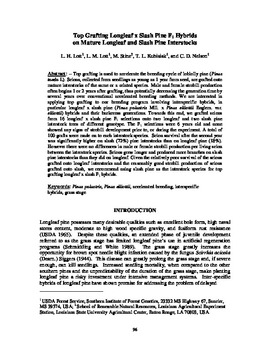| dc.contributor.author | Lott, L. H. | |
| dc.contributor.author | Lott, L. M. | |
| dc.contributor.author | Stine, M. | |
| dc.contributor.author | Kubisiak, T. L. | |
| dc.contributor.author | Nelson, C. D. | |
| dc.date.accessioned | 2016-04-25T19:36:00Z | |
| dc.date.available | 2016-04-25T19:36:00Z | |
| dc.date.issued | 2003 | |
| dc.identifier | oksd_sf27_p096.pdf | |
| dc.identifier.citation | Lott, L. H., Lott, L. M., Stine, M., Kubisiak, T. L., & Nelson, C. D. (2003_. "Top Grafting Longleaf x Slash Pine F1 Hybrids on Mature Longleaf and Slash Pine Interstocks." In 27th Southern Forest Tree Improvement Conference, Stillwater, OK | |
| dc.identifier.uri | https://hdl.handle.net/11244/33672 | |
| dc.description.abstract | Top grafting is used to accelerate the breeding cycle of loblolly pine (Pinus taeda L). Scions, collected from seedlings as young as 1 year from seed, are grafted onto mature interstocks of the same or a related species. Male and female strobili production often begins 1 or 2 years after grafting, thus potentially decreasing the generation time by several years over conventional accelerated breeding methods. We are interested in applying top grafting to our breeding program involving interspecific hybrids, in particular longleaf x slash pine (Pinus palustris Mill. x Pinus elliottii Englem. var. elliottii) hybrids and their backcross generations. Towards this end, we grafted scions from 16 longleaf x slash pine F1 selections onto two longleaf and two slash pine interstock trees of different genotype. The F1 selections were 6 years old and none showed any signs of strobili development prior to, or during the experiment. A total of 100 grafts were made on to each interstock species. Scion survival after the second year was significantly higher on slash (72%) pine interstocks than on longleaf pine (18%). However there were no differences in male or female strobili production per living scion between the interstock species. Scions grew longer and produced more branches on slash pine interstocks than they did on longleaf. Given the relatively poor survival of the scions grafted onto longleaf interstocks and the reasonably good strobili production of scions grafted onto slash, we recommend using slash pine as the interstock species for top grafting longleaf x slash F1 hybrids. | |
| dc.format | application/pdf | |
| dc.language | en_US | |
| dc.relation.ispartofseries | Sponsored publication . . . of the Southern Forest Tree Improvement Committee ; no. 49 | |
| dc.rights | This paper is made available through open access and the auspices of the fair use doctrine for scholarly, educational and research purposes while recognizing the publisher already offers a free online version. The OSU Library�s intent is to offer access and preserve publications involving its faculty contributions. Contact the Digital Resources and Discovery Services at lib-dls@okstate.edu or 405-744-9161 for the permission policy on the use, reproduction or distribution of this material. | |
| dc.source | Proceedings of the 27th Southern Forest Tree Improvement Conference, volume 27, 2003. Editor, Craig R. McKinley. | |
| dc.title | Top Grafting Longleaf x Slash Pine F1 Hybrids on Mature Longleaf and Slash Pine Interstocks | |
| dc.type | text | |
| osu.filename | oksd_sf27_p096.pdf | |
| dc.type.genre | Conference proceedings | |
| dc.subject.keywords | pinus palustris | |
| dc.subject.keywords | pinus elliottii | |
| dc.subject.keywords | accelerated breeding | |
| dc.subject.keywords | interspecific hybrids | |
| dc.subject.keywords | grass stage | |
| dc.description.scopeandcontents | Papers and abstracts from the 27th Southern Forest Tree Improvement Conference held at Oklahoma State University in Stillwater, Oklahoma on June 24-27, 2003. | |
